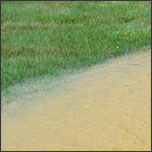High Levels of E. Coli Found In Water Samples

Have you been watching the news about the E. coli outbreak?
Do you fear that there could be E. coli in your backyard?
Recently, the news has been full of reports about E. coli outbreaks. In June of this year, New Orleans had an outbreak that tragically resulted in the death of an infant. Are you aware that water can carry E. coli? Did you know that when storm water collects and is not properly controlled, it can affect our lakes?
First of all, let’s start with what E. coli is. E. coli or Escherichia coli is bacteria that typically lives in the intestines of people and animals. The CDC says that:
“Most E. coli are harmless and actually are an important part of a healthy human intestinal tract. However, some E. coli are pathogenic, meaning they can cause illness, either diarrhea or illness outside of the intestinal tract. The types of E. coli that can cause diarrhea can be transmitted through contaminated water or food, or through contact with animals or persons.”
According to Soil Erosion & Hydroseeding, in the coves near the Lake of the Ozarks, the Missouri Departments of Natural Resources (DNR) and Health and Senior Services found that the levels of E. coli had exceeded the federal guidelines. These finding came from four samples of storm water where 3 out of the 4 had exceeded the EPA’s maximum recommendation for swimming areas (which is per 100 milliliters of water there must be less than 235 E. coli colonies.
How We Can Protect Our Backyards
To protect our backyards, install vertical cylinder channels or a Rootwells. Rootwells will collect storm water eliminating the buildup of the storm water on the surface. They deliver the water to the root zone instead of allowing it to it sit and where harmful bacteria like E. coli multiply. When Rootwells deliver storm water to the root zone of trees and shrubs, they also save you money and time because you will not have to water as often.



